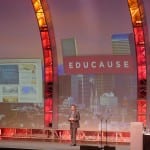From consumption to competency and creation
By Fiona Strawbridge, on 12 November 2012
 Three plenary talks nicely framed this year’s Educause conference and, in their own ways, called for the involvement of students in designing and building their learning experiences and outcomes.
Three plenary talks nicely framed this year’s Educause conference and, in their own ways, called for the involvement of students in designing and building their learning experiences and outcomes.
Clay Shirky (author of ‘Here Comes Everybody’ and ‘Cognitive Surplus’) opened the conference by talking about the way in which technology (especially social media) is enabling us to use our collective cognitive surplus to do increasingly creative and productive things in our spare time; we still like to consume, but we also like to create and share. This socially mediated approach to creativity has unexpected benefits for society and from education. Shirky argued that the interesting thing about MOOCs is not their massiveness, but their openness and potential for sharing.
In the keynote ‘blueprint for change’ talk Christine Flanagan (Student Experience Director from the Business Innovation Factory) talked about a ‘student experience lab‘ which had travelled the US and found that many are unprepared for student life and want more from higher education, some questioning the importance of a degree. In the same session Elliot Masie (expert in workplace learning – see Masie.com) had pointed out that in many subjects the half life of what people learn is less than four years and so the ability to update knowledge and skills is essential – we all need to be lifelong learners and our campuses need to accommodate multi-generational learners. Both argued that we need to take risks and accept failure in developing new approaches to teaching and learning.
Flanagan argued that students are less immersed in their studies than in previous generations which means that there needs to be better incorporation of extracurricular achievements into their HE outcomes. She claimed that competency-based learning, in which students demonstrate mastery of a series of tasks which can be rolled up into a degree, is an effective approach. In contrast Ed Ayers, in the closing plenary, focused on the need for students to be able to deal with the kinds of complex and contested subjects in which complexity is accepted; knowledge is not just learned but must be created, aggregated and synthesised. He bemoaned the focus of much e-learning on teaching procedural and processural topics (especially in STEM subjects) that can be taught in chunks and called for its development to help aggregate and visualise information to create new knowledge and understanding – digital scholarship or generative scholarship. Ayers’ insitution – the University of Richmond – has a Digital Scholarship Lab which involves computer scientists working with humanities academics and students. Ayers showed wonderful examples of animated maps telling some of the human and political stories behind the emancipation of slaves during the American civil war in very direct and graphical ways. He argued that by focusing on the use of technology to drill and grill, we are missing its potential to create and transform understanding.
It seems to me that although Ayers appeared to be have a very different perspective from Flanagan and Masie, the two could be reconciled if we can involve students in designing and developing new ways to use technology to go beyond knowledge consumption and find new ways to create, present, aggregate and synthesise information to allow new understandings to emerge. Flanagan had suggested that if you want new models you could talk to innovators, look to industry, or talk to students, and that student involvement can help break down silos within an institution and promote experimentation.
For some academics who already have the necessary imagination, skills and access to technologies (which are probably not those traditionally viewed as ‘learning technologies’), and who are willing to work collaboratively with students, this may be relatively straightforward; for many though it may involve partnerships with learning technologists, and experimentation with unfamiliar technologies with help from research support staff. And of course the involvement of students in design and implementation needs to be carefully managed. But in all won’t this support both deeper learning whilst also providing the kinds of practical experience that will enhance students’ wider skills and employability? And, going back to Shirky’s opening remarks, make good use of some of our collective cognitive surplus.
 Close
Close



